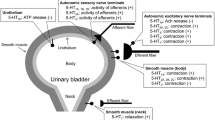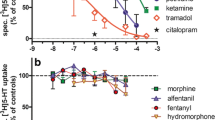Abstract
5-Hydroxytryptamine 5-HT1B/5-HT1D receptors are members of the same receptor subfamily, but display a different pharmacology (Hartig et al. (1992) Trends Pharmacol Set 13:152–159). Whereas several cell lines have been reported to contain 5-HT1B receptors, none has been described, however, that endogenously expresses well-characterized 5-HT1D receptors. The present study deals with the identification of 5-HT1D receptors inhibiting cyclic AMP accumulation in Madin-Darby canine kidney (MDCK) cells. 5-HT (1 nM− 10 μM) induced a concentration-dependent inhibition of the cyclic AMP accumulation stimulated by prostaglandin E1 (1 μM) in MDCK cells. The maximal effect of 5-HT averaged 50% inhibition and was abolished after a pre-treatment of the cells with pertussis toxin. Other agonists mimicked the effects of 5-HT, with the following rank order of potency (pEC50 ± SEM, n ≥ 3): 5-carboxamidotryptamine (8.36 ± 0.48) > PAPP (p-aminophenylethyl-m-trifluoromethylphenyl piperazine, 7.89 ± 0.23) > 5-HT (7.35 ± 0.05) > sumatriptan (6.65 ± 0.27). PAPP behaved as a partial agonist. 8-OH-DPAT (8-hydroxy-2(di-n-propylamino)tetralin) was less potent, its maximal effect being not reached at 0.1 mM. Methiothepin, GR127935, (−)propranolol, rauwolscine and ketanserin were all devoid of intrinsic activity (up to 10 μM or 0.1 mM). Methiothepin (10 nM, 0.1 μM and 1 μM) antagonized 5-HT effect (pA2 8.57 ± 0.44, Schild slope 1.17 ± 0.21, n = 3). GR127935 (1 nM, 10 nM and 0.1 μM) shifted the curve of 5-HT to the right, but the antagonism was not fully surmountable (apparent pKB value, 9.80 ± 0.16, n = 9). From the shifts obtained with rauwolscine (1 μM) and (−)propranolol (10 μM), respective pKB values were estimated 6.68 ± 0.30 and ≈ 5.4 (n = 3 each). PAPP, when tested as an antagonist at 1 μM, also shifted the curve of 5-HT to the right, with a pKB of 8.27 ± 0.16 (n = 3). Finally, ketanserin (10 μM) also antagonized the effects of 5-HT, the pKB being 6.54 ± 0.16 (n = 9). The rank orders of agonist and antagonist potencies strongly suggest 5-HT receptors mediating inhibition of cyclic AMP accumulation in MDCK cells to be 5-HT1D receptors. This is the first report of a cell line expressing endogenous, well-characterized, 5-HT1D receptors. With regard to the 5-HT1D receptor subtype involved, the relatively high potency of ketanserin would suggest it to be a 5-HT1Dα subtype or a mixture of 5-HT1Dα/5-HT1D\ subtypes. However, caution must be exercised here, owing to the poor knowledge of canine 5-HT1D receptor subtypes.
Similar content being viewed by others
References
Arunlakshana O, Schild HO (1959) Some quantitative uses of drug antagonists. Br J Pharmacol Chemother 14:48–58
Bockaert J, Dumuis A, Bouhelal R, Sebben M, Cory RN (1987) Piperazine derivatives including the putative anxiolytic drugs, buspirone and ipsapirone, are agonists at 5-HT1A receptors negatively coupled with adenylate cyclase in hippocampal neurones. Naunyn-Schmiedeberg's Arch Pharmacol 335:588–592
Bradley PB, Engel G, Feniuk W, Fozard JR, Humphrey PPA, Middlemiss DN, Mylecharane EJ, Richardson BP, Saxena PR (1986) Proposals for the classification and nomenclature of functional receptors for 5-hydroxytryptamine. Neuropharmacology 25:563–576
Bruinvels AT, Lery H, Nozulak J, Palacios JM, Hoyer D (1992) 5-HT1D binding sites in various species: similar pharmacological profile in dog, monkey, calf, guinea-pig and human brain membranes. Naunyn-Schmiedeberg's Arch Pharmacol 346:243–248
Cattaneo MG, Palazzi E, Bondiolotti G, Vicentini LM (1994) 5HT1D receptor type is involved in stimulation of cell proliferation by serotonin in human small cell lung carcinoma. Eur J Pharmacol Mol Pharmacol Sect 268:425–430
Ciaranello RD, Tan GL, Dean R (1990) G-protein-linked serotonin receptors in mouse kidney exhibit identical properties to 5-HT1B receptors in brain. J Pharmacol Exp Ther 252:1347–1354
Clitherow JW, Scopes DIC, Skingle M, Jordan CC, Feniuk W, Campbell IB, Carter MC, Collington EW, Connor HE, Higgins GA, Beattie D, Kelly HA, Mitchell WL, Oxford AW, Wadsworth AH, Tyers MB (1994) Evolution of a novel series of [(N,N-dimethylamino)propyl]-and piperazinylbenzanilides as the first selective 5-HT1D antagonists. J Med Chem 37:2253–2257
DeLéan A, Stadel JM, Lefkowitz RJ (1980) A ternary complex model explains the agonist-specific binding properties of the adenylate cyclase-coupled \-adrenergic receptor. J Biol Chem 255: 7108–7117
De Vivo M, Maayani S (1986) Characterization of the 5-hydroxytryptamine1A receptor-mediated inhibition of forskolin-stimulated adenylate cyclase activity in guinea-pig and rat hippocampal membranes. J Pharmacol Exp Ther 238:248–253
Ebersole BJ, Diglio CA, Kaufman DW, Berg KA (1993) 5-Hydroxytryptamine1-like receptors linked to increases in intracellular calcium concentration and inhibition of cyclic AMP accumulation in cultured vascular smooth muscle cells derived from bovine basilar artery. J Pharmacol Exp Ther 266:692–699
Gausch CR, Hard WL, Smith TF (1966) Characterization of an established line of canine kidney cells (MDCK). Proc Soc Exp Biol Med 122:931–935
Galzin AM, Poirier MF, Lista A, Chodkiewicz JP, Blier P, Ramdine R, Loô H, Roux FX, Redondo A, Langer SZ (1992) Characterization of the 5-hydroxytryptamine receptor modulating the release of 5-[3H]hydroxytryptamine in slices of the human neocortex. J Neurochem 59:1293–1301
Giles H, Lansdell SJ, Fox P, Lockyer M, Hall V, Martin GR (1994) Characterisation of a 5-HT1B receptor on CHO cells: functional responses in the absence of radioligand binding. Br J Pharmacol 112:317P
Hamblin MW, Metcalf MA (1991) Primary structure and functional characterization of a human 5-HT1D-type serotonin receptor. Mol Pharmacol 40:143–148
Hamel E, Bouchard D (1991) Contractile 5-HT1 receptors in human isolated pial arterioles: correlation with 5-HT1D binding sites. Br J Pharmacol 102:227–233
Hamel E, Fan E, Linville D, Ting V, Villemure J-G, Chia L-S (1993) Expression of mRNA for the serotonin 5-hydroxytryptamine1D\receptor subtype in human and bovine cerebral arteries. Mol Pharmacol 44:242–246
Harel-Dupas C, Cloëz I, Fillion G (1991) The inhibitory effect of trifluoromethylphenylpiperazine on [3H]acetylcholine release in guinea-pig hippocampal synaptosomes is mediated by a 5-hydroxytryptamine1 receptor distinct from 1A, 1B, and 1C subtypes. J Neurochem 56:221–227
Hartig P, Branchek TA, Weinshank RL (1992) A subfamily of 5-HT1D receptor genes. Trends Pharmacol Sci 13:152–159
Herzlinger DA, Easton TG, Ojakian GK (1982) The MDCK epithelial line expresses a cell surface antigen of the kidney distal tubule. J Cell Biol 93:269–277
Heuring RE, Peroutka SJ (1987) Characterization of a novel 3H-5-hydroxytryptamine binding site subtype in bovine brain membranes. J Neurosci 7:894–903
Hoyer D (1988) 5-Hydroxytryptamine receptors and effector coupling mechanisms in peripheral tissues. In: Fozard JR (ed) The peripheral actions of 5-hydroxytryptamine. Oxford University Press, Oxford New York Tokyo, pp 72–99
Hoyer D, Middlemiss DN (1989) Species differences in the pharmacology of terminal 5-HT autoreceptors in mammalian brain. Trends Pharmacol Sci 10:130–132
Hoyer D, Clarke DE, Fozard JR, Hartig PR, Martin GR, Mylecharane EJ, Saxena PR, Humphrey PPA (1994) International Union of Pharmacology classification of receptors for 5-hydroxytryptamine (serotonin). Pharmacol Rev 46:157–203
Humphrey PPA, Hartig P, Hoyer D (1993) A proposed new nomenclature for 5-HT receptors. Trends Pharmacol Sci 14:233–236
Kaumann AJ, Frenken M, Posival H, Brown AM (1994) Variable participation of 5-HT1-like receptors and 5-HT2 receptors in serotonin-induced contraction of human isolated coronary arteries. 5-HT1-like receptors resemble cloned 5-HT1D\ receptors. Circulation 90:1141–1153
Libert F, Parmentier M, Lefort A, Dinsart C, Van Sande J, Maenhaut C, Simons MJ, Dumont JE, Vassart G (1989) Selective amplification and cloning of four new members of the G-protein-coupled receptor family. Science 244:569–572
Limberger N, Deicher R, Starke (1991) Species differences in presynaptic serotonin autoreceptors: mainly 5-HT1B but possibly in addition 5-HT1D in the rat, 5-HT1D in the rabbit and guinea-pig brain cortex. Naunyn-Schmiedeberg's Arch Pharmacol 343:353–364
Maenhaut C, Van Sande J, Massart C, Dinsart C, Libert F, Monferini E, Giraldo E, Ladinsky H, Vassart G, Dumont JE (1991) The orphan receptor cDNA RDC4 encodes a 5-HT1D serotonin receptor. Biochem Biophys Res Commun 180:1460–1468
Mangoo-Karim R, Uchic ME, Grant M, Shumate WA, Calvet JP, Park CH, Grantham JJ (1989) Renal epithelial fluid secretion and cyst growth: the role of cyclic AMP. FASEB J 3:2629–2632
Middlemiss DN, Bremer ME, Smith SM (1988) A pharmacological analysis of the 5-HT receptors mediating inhibition of 5-HT release in the guinea-pig frontal cortex. Eur J Pharmacol 157:101–107
Molderings GJ, Werner K, Likungu J, Göthert M (1990) Inhibition of noradrenaline release from the sympathetic nerves of the human saphenous vein via presynaptic 5-HT receptors similar to the 5-HT1D subtype. Naunyn-Schmiedeberg's Arch Pharmacol 342:371–377
Murphy TJ, Bylund DB (1989) Characterization of serotonin-1B receptors negatively coupled to adenylate cyclase in OK cells, a renal epithelial cell line from the Opossum. J Pharmacol Exp Ther 249:535–543
Salomon Y (1991) Cellular responsiveness to hormones and neurotransmitters: conversion of [3H]adenine to [3H]cAMP in cell monolayers, cell suspension, and tissue slices. Methods Enzymol 195:22–28
Schlicker E, Fink K, Göthert M, Hoyer D, Molderings G, Roschke I, Schoeffter P (1989) The pharmacological properties of the presynaptic serotonin autoreceptorin the pig brain cortex conform to the 5-HT1D receptor subtype. Naunyn-Schmiedeberg's Arch Pharmacol 340:45–51
Schoeffter P, Hoyer D (1989a) Interaction of arylpiperazines with 5-HT1A, 5-HT1B, 5-HT1C and 5-HT1D receptors: do discriminatory 5-HT1B receptor ligands exist? Naunyn-Schmiedeberg's Arch Pharmacol 339:675–683
Schoeffter P, Hoyer D (1989b) How selective is GR 43175? Interactions with functional 5-HT1A, 5-HT1B, 5-HT1C and 5-HT1D receptors. Naunyn-Schmiedeberg's Arch Pharmacol 340:135–138
Schoeffter P, Hoyer D (1989c) 5-Hydroxytryptamine 5-HT1B and 5-HT1D receptors mediating inhibition of adenylate cyclase activity. Pharmacological comparison with special reference to the effects of yohimbine, rauwolscine and some \-adrenoceptor antagonists. Naunyn-Schmiedeberg's Arch Pharmacol 340: 285–292
Schoeffter P, Waeber C, Palacios JM, Hoyer D (1988) The 5-hydroxytryptamine 5-HT1D receptor subtype is negatively coupled to adenylate cyclase in calf substantia nigra. Naunyn-Schmiedeberg's Arch Pharmacol 337:602–608
Schoeffter P, Pfeilschifter J, Bobirnac I(1995) 5-Hydroxytryptamine 5-HT1B receptors inhibiting cyclic AMP accumulation in rat renal mesangial cells. Naunyn-Schmiedeberg's Arch Pharmacol 351:35–39
Seuwen K, Magnaldo I, Pouysségur J (1988) Serotonin stimulates DNA synthesis in fibroblasts acting through 5-HT1B receptors coupled to a Gi-protein. Nature 335:254–256
Skingle M, Scopes DIC, Feniuk W, Connor HE, Carter MC, Clitherow JW, Tyers MB (1993) GR127935: a potent orally active 5-HT1D receptor antagonist. Br J Pharmacol 110:9P
Waeber C, Schoeffter P, Palacios JM, Hoyer D (1988) Molecular pharmacology of 5-HTP1D recognition sites: radioligand binding studies in human, pig and calf brain membranes. Naunyn-Schmiedeberg's Arch Pharmacol 337:595–601
Waeber C, Schoeffter P, Palacios JM, Hoyer D (1989) 5-HT1D receptors in guinea-pig and pigeon brain. Radioligand binding and biochemical studies. Naunyn-Schmiedeberg's Arch Pharmacol 340:479–485
Weinshank RL, Zgombick JM, Macchi MJ, Branchek TA, Hartig PR (1992) Human serotonin 1D receptor is encoded by a subfamily of two distinct genes: 5-HT1Dα and 5-HT1D\. Proc Natl Acad Sci USA 89:3630–3634
Zgombick JM, Weinshank RL, Macchi M, Schechter LE, Branchek TA, Hartig PR (1991) Expression and pharmacological characterization of a canine 5-hydroxytryptamine1D receptor subtype. Mol Pharmacol 40:1036–1042
Author information
Authors and Affiliations
Rights and permissions
About this article
Cite this article
Schoeffter, P., Bobirnac, I. 5-Hydroxytryptamine 5-HT1D receptors mediating inhibition of cyclic AMP accumulation in Madin-Darby canine kidney (MDCK) cells. Naunyn-Schmiedeberg's Arch Pharmacol 352, 256–262 (1995). https://doi.org/10.1007/BF00168555
Received:
Accepted:
Issue Date:
DOI: https://doi.org/10.1007/BF00168555




